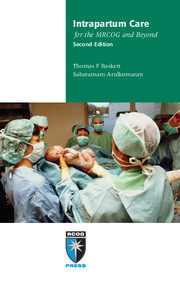Book contents
- Frontmatter
- Contents
- Preface
- Abbreviations
- 1 Improving intrapartum care
- 2 First stage of labour
- 3 Second stage of labour
- 4 Fetal surveillance in labour
- 5 Third stage of labour
- 6 Lower genital tract trauma
- 7 Induction of labour
- 8 Preterm labour and prelabour rupture of membranes
- 9 Assisted vaginal delivery
- 10 Shoulder dystocia
- 11 Breech vaginal delivery
- 12 Twin and triplet delivery
- 13 Caesarean section
- 14 Vaginal birth after caesarean section
- 15 Uterine rupture
- 16 Emergency obstetric hysterectomy
- 17 Cord prolapse
- 18 Antepartum haemorrhage
- 19 Postpartum haemorrhage
- 20 Acute uterine inversion
- 21 Amniotic fluid embolism
- 22 Disseminated intravascular coagulation
- 23 Acute tocolysis
- 24 Severe pre-eclampsia and eclampsia
- 25 Neonatal resuscitation
- 26 Perinatal loss: management of late fetal death and stillbirth
- Index
10 - Shoulder dystocia
Published online by Cambridge University Press: 05 July 2014
- Frontmatter
- Contents
- Preface
- Abbreviations
- 1 Improving intrapartum care
- 2 First stage of labour
- 3 Second stage of labour
- 4 Fetal surveillance in labour
- 5 Third stage of labour
- 6 Lower genital tract trauma
- 7 Induction of labour
- 8 Preterm labour and prelabour rupture of membranes
- 9 Assisted vaginal delivery
- 10 Shoulder dystocia
- 11 Breech vaginal delivery
- 12 Twin and triplet delivery
- 13 Caesarean section
- 14 Vaginal birth after caesarean section
- 15 Uterine rupture
- 16 Emergency obstetric hysterectomy
- 17 Cord prolapse
- 18 Antepartum haemorrhage
- 19 Postpartum haemorrhage
- 20 Acute uterine inversion
- 21 Amniotic fluid embolism
- 22 Disseminated intravascular coagulation
- 23 Acute tocolysis
- 24 Severe pre-eclampsia and eclampsia
- 25 Neonatal resuscitation
- 26 Perinatal loss: management of late fetal death and stillbirth
- Index
Summary
Shoulder dystocia occurs when there is failure of the shoulders to deliver spontaneously or with gentle downward traction on the fetal head. Shoulder dystocia is diagnosed when the head is delivered but external rotation does not occur, the head recedes with the chin firmly against the vulva and the neck is not visible or palpable. The diagnosis is, to some extent, in the eye of the beholder, which accounts for the relatively wide range of incidence: 0.2–2% of cephalic vaginal deliveries. It has been suggested that a more standard definition may be an interval between delivery of the head to completion of delivery greater than 60 seconds, or the use of ancillary manoeuvres to effect delivery of the shoulders. However, even in normal deliveries without shoulder dystocia, the head may deliver with the final push of one contraction and the shoulders and rest of the infant after awaiting the next contraction. The potential for damage to the infant from asphyxia and trauma is such that shoulder dystocia has assumed considerable clinical and medico-legal significance.
Mechanism
The anteroposterior diameter of the pelvic brim is narrower than the oblique and transverse diameters. The bisacromial diameter of the term fetus is larger than the biparietal diameter. Therefore, it is the flexibility of the shoulders that allows their rotation, accommodation and descent through the pelvis. In spontaneous delivery, as the head passes through the pelvic outlet the posterior fetal shoulder descends through the sciatic notch or the sacral bay, while the anterior shoulder is accommodated in the retropubic space and the obturator foramen.
- Type
- Chapter
- Information
- Intrapartum Care for the MRCOG and Beyond , pp. 117 - 132Publisher: Cambridge University PressPrint publication year: 2011



